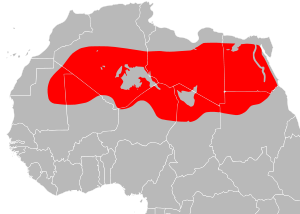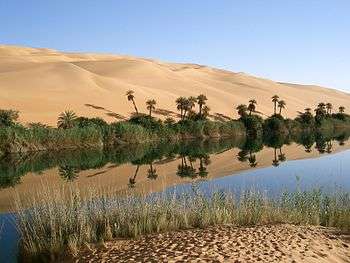Sahara Desert (ecoregion)
| Sahara | |
|---|---|
|
Sand dunes in Tadrart Acacus, a desert area in western Libya | |
 | |
| Ecology | |
| Realm | Palearctic |
| Biome | Deserts and xeric shrublands |
| Geography | |
| Area | 4,619,260 km2 (1,783,510 sq mi) |
| Countries | Algeria, Chad, Egypt, Libya, Mali, Mauritania and Niger |
| Rivers | Nile River; intermittent rivers and streams |
| Climate type | hot desert and hyper-arid |
| Conservation | |
| Conservation status | Vulnerable |
The Sahara Desert ecoregion, as defined by the World Wide Fund for Nature (WWF), includes the hyper-arid center of the Sahara, between 18° and 30° N.[1] It is one of several desert and xeric shrubland ecoregions that cover the northern portion of the African continent.
Setting
The Sahara Desert is the world's largest hot desert, located in North Africa. It stretches from the Red Sea to the Atlantic Ocean. The vast desert encompasses several ecologically distinct regions. The Sahara Desert ecoregion covers an area of 4,619,260 km2 (1,783,510 sq mi) in the hot, hyper-arid center of the Sahara, surrounded on the north, south, east, and west by desert ecoregions with higher rainfall and more vegetation.[1]
The North Saharan steppe and woodlands ecoregion lies to the north and west, bordering the Mediterranean climate regions of Africa's Mediterranean and North Atlantic coasts. The North Saharan steppe and woodlands receives more regular winter rainfall than the Sahara Desert ecoregion. The South Saharan steppe and woodlands ecoregion lies to the south, between the Sahara Desert ecoregion and the Sahel grasslands. The South Saharan steppe and woodlands receives most of its annual rainfall during the summer. The Red Sea coastal desert lies in the coastal strip between the Sahara Desert ecoregion and the Red Sea.
Some mountain ranges rise up from the desert and receive more rainfall and cooler temperatures. These Saharan mountains are home to two distinct ecoregions; the West Saharan montane xeric woodlands in the Ahaggar, Tassili n'Ajjer, Aïr, and other ranges in the western and central Sahara Desert, and the Tibesti-Jebel Uweinat montane xeric woodlands in the Tibesti and Jebel Uweinat of the eastern Sahara.

The surface of the desert ranges from large areas of sand dunes (erg), to stone plateaus (hamadas), gravel plains (reg), dry valleys (wadis), and salt flats. The only permanent river that crosses the ecoregion is the Nile River, which originates in central Africa and empties northwards into the Mediterranean Sea. Some areas encompass vast underground aquifers resulting in oases, while other regions severely lack water reserves.
Climate
The Sahara Desert features a hot desert climate (Köppen climate classification BWh). The Sahara Desert is one of the driest and hottest regions of the world, with a mean temperature sometimes over 30 °C (86 °F) and the averages high temperatures in summer are over 40 °C (104 °F) for months at a time, and can even soar to 47 °C (117 °F). In desert rocky mountains such as the Tibesti in Libya or the Hoggar in Algeria, averages highs in summer are slightly moderated by the high elevation and are between 35 and 42 °C (95 and 108 °F) at 1,000 to 1,500 metres (3,300 to 4,900 ft) elevation. Daily variations may also be extreme: a swing from 37.5 to −0.5 °C (100 to 31 °F) has been observed.[1] Typical temperature swings are between 15 and 20 °C (27 and 36 °F).
Precipitation in the Sahara Desert is scarce, as the whole desert generally receives less than 100 millimetres (3.9 in) of rain per year except on the northernmost and southernmost edge as well as in the highest desert mountains. More than half of the desert area is hyper-arid and virtually rainless, with an average annual precipitation below 50 millimetres (2.0 in) and many consecutive years may pass without any rainfall. The south of the Sahara Desert, along the boundary with the hot semi-arid climate (BSh) of the Sahel, receives most of its annual rainfall during the highest-sun months (summer) when the Inter-Tropical Convergence Zone moves up from the south.[1] Wind- and sandstorms occur in early spring. Local inhabitants protect themselves from the heat, the sunshine, the dry air, the high diurnal temperature ranges and the sometimes dusty or sandy winds by covering their heads, such as the cheche garment worn by Tuareg.
History and conservation
The Sahara was one of the first regions of Africa to be farmed. Some 5,000 years ago, the area was not so arid and the vegetation might have been closer to a savanna. Previous fauna may be recognised in stone carvings. However, desertification set in around 3000 BCE, and the area became much like it is today.
The Sahara is largely undisturbed.[1] The most degradation is found in areas where there is water, such as aquifer oases or along the desert margins where some rain usually falls most years. In these areas, animals such as addaxes, scimitar-horned oryxes, and bustards are over-hunted for their meat. Only one area of conservation is recorded in the Sahara: the Zellaf Nature Reserve in Libya.[1]
